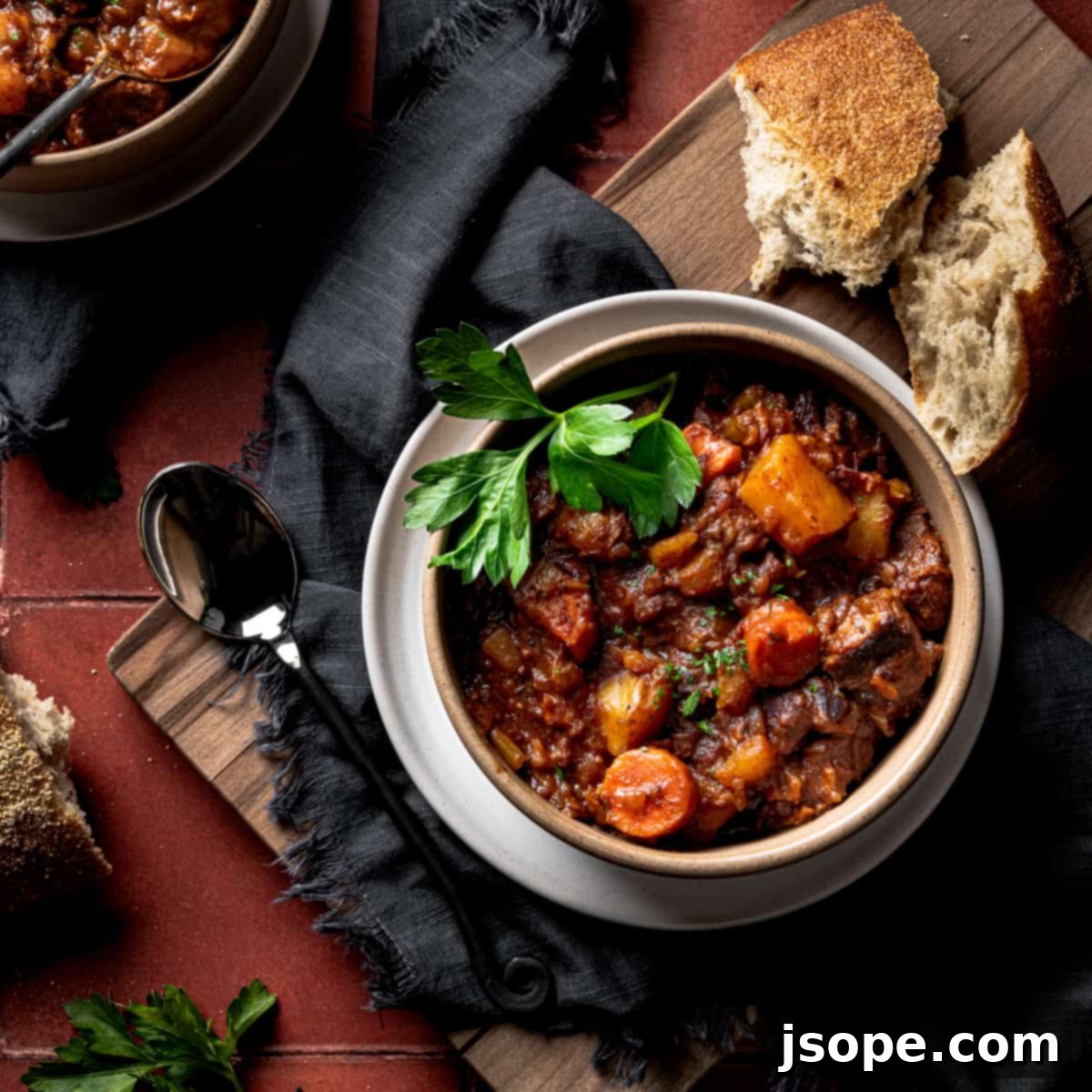Indulge in the unparalleled comfort of a rich, savory Guinness Beef Stew – a culinary journey inspired by the hearty traditions of Ireland! This exceptional recipe transforms humble ingredients into a deeply flavorful, warming dish that’s perfect for chilly evenings, festive gatherings, or a comforting weekend meal. Crafted with the iconic Guinness stout, this stew boasts a robust flavor profile, tender pieces of succulent beef, and a medley of nourishing vegetables and aromatic herbs, creating an experience that truly embodies the spirit of Irish cuisine. Prepare to warm your soul all winter long and celebrate St. Patrick’s Day with this truly authentic and satisfying stew.
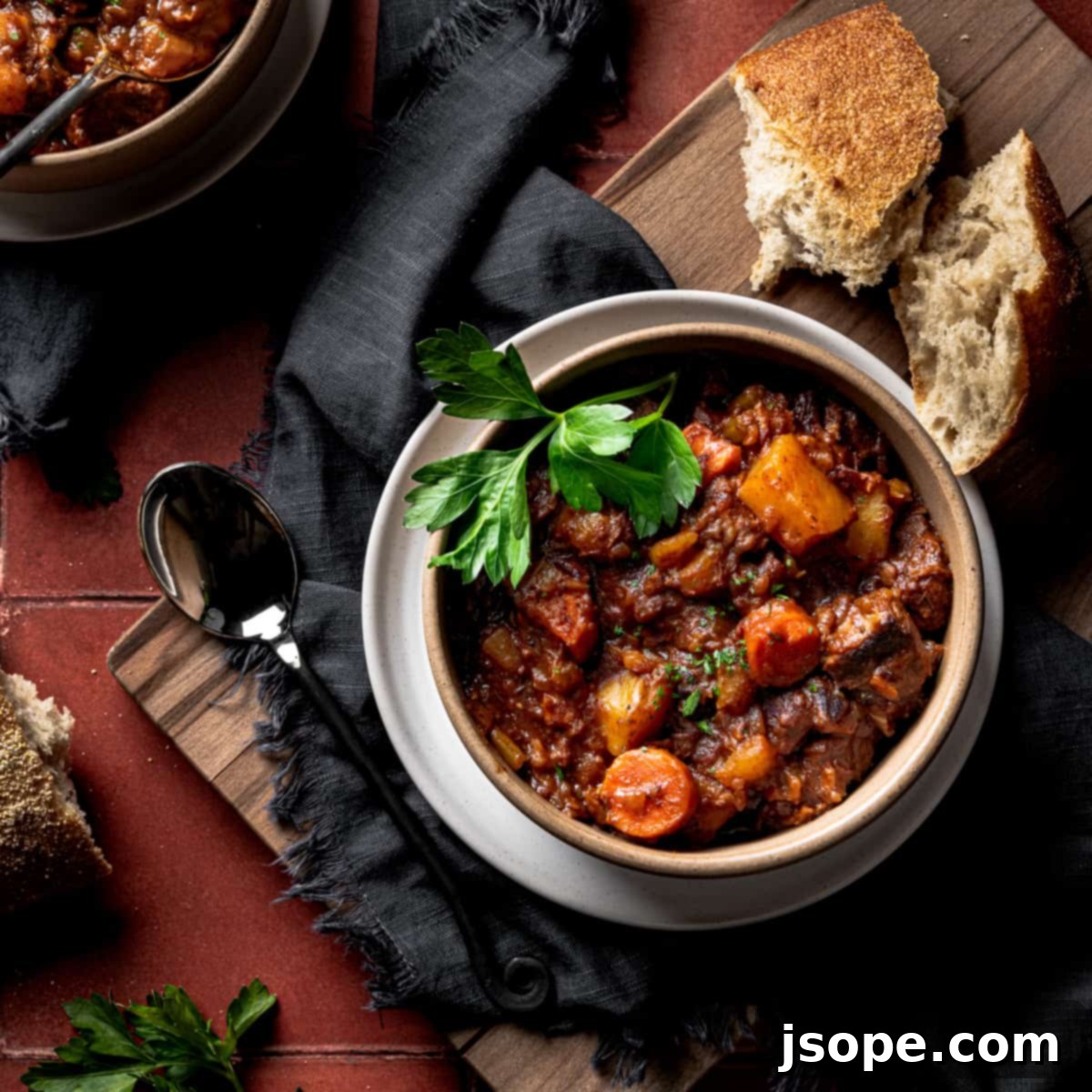
Craving more comforting and flavorful dishes? Explore our collection of heartwarming recipes, including our Creamy Three Bean Chicken Stew or our delightful Steak and Ale Pot Pies for more delicious inspiration.
Why This Guinness Beef Stew Will Become Your Go-To Recipe
Our Guinness Beef Stew isn’t just a meal; it’s an experience. Here’s why this recipe stands out and is sure to become a beloved staple in your kitchen:
- Effortless Cooking: While the flavors are complex, the preparation is surprisingly straightforward. Most of the cooking time is spent in the oven, allowing the stew to simmer slowly and develop its rich taste with minimal hands-on effort from your side. This makes it an ideal dish for busy weeknights or relaxed weekend cooking.
- One-Pot Wonder: Say goodbye to piles of dirty dishes! This entire delicious meal comes together in a single pot, from searing the beef to slow-cooking in the oven. This not only simplifies cleanup but also ensures all those incredible flavors meld perfectly in one vessel.
- Better with Time: Like many great stews, this Guinness Beef Stew improves significantly with age. The flavors deepen and harmonize even further the next day, making it an excellent option for meal prepping. Enjoying it as leftovers means an even richer, more integrated taste sensation.
- Unbelievably Tender Meat: Through the magic of slow cooking, the beef transforms into incredibly tender, melt-in-your-mouth morsels. The long, gentle simmer in the flavorful Guinness broth breaks down the tough fibers, ensuring every bite of meat is succulent and falls apart beautifully.
- The Ultimate Comfort Food: On a cold, damp, or dreary day, there’s truly nothing more satisfying than a steaming bowl of this hearty beef stew. Its deep, rich flavors, combined with a robust texture, provide unparalleled warmth and comfort, making it the perfect antidote to any chill.
Understanding Guinness Beef Stew: A Taste of Ireland
Guinness Beef Stew is a beloved modern interpretation of Ireland’s cherished national dish, Irish Stew. While traditional Irish stew typically features mutton or lamb as its primary meat, sometimes incorporating beef, this version proudly highlights the iconic Guinness Stout as a core flavoring agent. This dark, rich beer imparts a distinctive malty depth and subtle bitterness that is simply essential to the stew’s unique character. Our recipe embraces the classic root vegetables commonly found in traditional Irish stews, such as tender potatoes and aromatic onions, alongside sweet carrots and fresh parsley. To further enhance the complexity and heartiness of the dish, we’ve added crisp celery and earthy turnips, creating a truly memorable stew that pairs wonderfully with a pint of Guinness on even the coldest, grayest days. It’s a culinary journey to the Emerald Isle, right in your own kitchen.
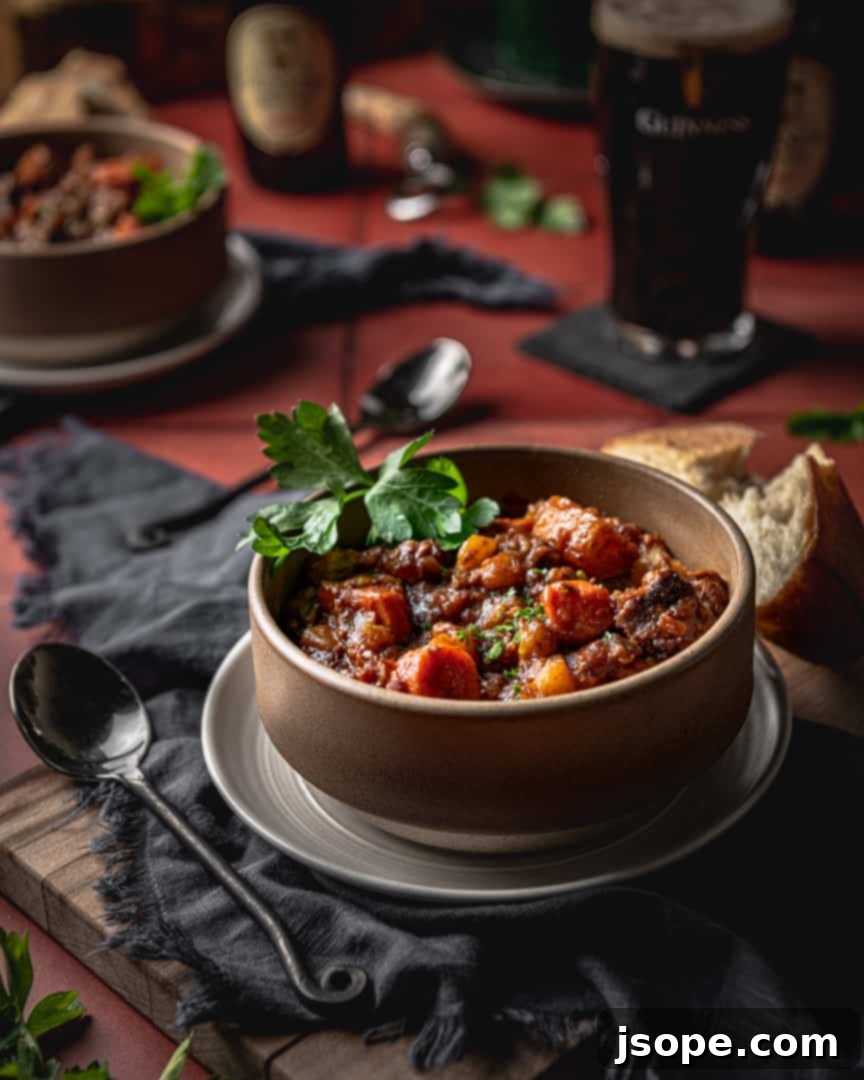
Essential Ingredients for a Flavorful Guinness Beef Stew
Crafting a truly exceptional Guinness Beef Stew begins with selecting high-quality ingredients. Each component plays a crucial role in building the deep, complex flavors that define this comforting dish. Here’s a detailed look at what you’ll need:
- Bacon: A small amount of bacon, cut into half-inch pieces, serves as the initial flavor builder. Its rendered fat provides a rich base for browning the beef and sautéing vegetables, while the crispy bits add a delightful smoky depth and textural contrast to the finished stew.
- Beef: For optimal tenderness and flavor in this slow-cooked stew, we highly recommend using sirloin. This cut boasts excellent flavor and becomes incredibly tender when cooked slowly, resisting the dryness that can sometimes affect other cuts.
- All-Purpose Flour: Flour is key for two reasons: it lightly coats the beef cubes, aiding in achieving a beautiful brown crust during searing, and it acts as a thickening agent for the stew’s luxurious, rich broth.
- Onion: A cornerstone of almost any savory stew, onions provide a foundational sweetness and aromatic depth. We typically use yellow onions for their balanced flavor, but any common onion variety will contribute beautifully to the stew.
- Garlic: Just a touch of minced garlic is all it takes to infuse the stew with its pungent, aromatic notes, enhancing the overall savory profile without overpowering the other ingredients.
- Tomato Paste: Don’t underestimate the power of tomato paste! A generous amount is used here to create an incredible depth of umami and a subtle sweetness that balances the richness of the beer, without making the stew taste overtly “tomatoey.” It’s a secret weapon for complexity.
- Potatoes: Alongside the beef, potatoes are a non-negotiable ingredient in this stew. They absorb the rich broth, become wonderfully tender, and contribute to the hearty, fulfilling nature of the dish. Waxy varieties hold their shape best.
- Turnips: An often-underrated root vegetable, turnips add a unique, slightly peppery and earthy flavor to the stew. When diced and slow-cooked, they become tender and contribute to the rustic charm of the dish.
- Carrots: These vibrant root vegetables not only add a pop of color but also a natural sweetness that beautifully contrasts with the subtle bitterness of the Guinness and turnips. They soften wonderfully, becoming an integral part of the stew’s texture.
- Celery: While not a dominant flavor, celery provides a subtle aromatic background and a fresh, clean note that brightens the overall profile of the stew, contributing to the classic mirepoix base.
- Guinness Beer: The star ingredient! Guinness Draught in a can is our preferred choice, as its creamy, malty, and slightly bitter characteristics are absolutely critical to developing the deep, iconic flavor of this stew. It truly sets it apart.
- Beef Stock: A high-quality beef stock is essential for building the stew’s flavorful liquid base. Opt for a low-sodium version if possible, allowing you to control the seasoning precisely.
- Worcestershire Sauce: This versatile condiment is an umami powerhouse. Its complex blend of savory, tangy, and sweet notes adds an indispensable layer of depth and richness to the stew.
- Fresh Herbs (Oregano, Rosemary, Thyme): A fragrant trio of fresh oregano, rosemary, and thyme elevates the stew’s aroma and taste profile. These classic herbs infuse the broth with their distinctive earthy and savory notes, creating a truly aromatic experience.
- Dried Marjoram: Given that fresh marjoram can be challenging to find, dried marjoram works wonderfully here. It offers a delicate, sweet, and slightly floral flavor that complements the other herbs beautifully.
- Bay Leaves: Just a couple of small bay leaves are steeped in the stew, releasing a subtle, earthy, and slightly minty aroma that adds another layer of complexity to the overall flavor.
- Kosher Salt: We advocate for kosher salt in all our recipes for its clean taste and ease of measurement. It’s crucial for seasoning the stew perfectly, enhancing all the other flavors.
- Black Pepper: A foundational seasoning in almost every savory dish, freshly cracked black pepper adds a gentle warmth and spice that perfectly rounds out the stew’s taste.
- Molasses: With several bitter elements from the beer and turnips, a touch of molasses is a game-changer. It introduces a deep, complex sweetness that harmonizes all the flavors, rounding out the dish beautifully without making it overly sweet.
- Fresh Parsley: A generous sprinkle of fresh chopped parsley at the end serves as a vibrant garnish, adding a touch of freshness, color, and a delicate herbal note that brightens each serving.
For precise quantities, please refer to the recipe card below.
Smart Substitutions for Your Guinness Beef Stew
While we believe our recipe offers the perfect balance of flavors and textures, we understand that sometimes substitutions are necessary or desired. Here are some common and effective alternatives for ingredients in this hearty stew:
- Beef Cuts: If sirloin isn’t available, other cuts of beef can be used, though they may require slight adjustments to cooking time to achieve the desired tenderness. Top round and chuck roast are good substitutes. Chuck roast, with its higher fat content, will result in a very rich and tender stew, but it might need a slightly longer cooking time than sirloin to become truly fall-apart tender. Lamb can also be used for a more traditional Irish stew flavor.
- Root Vegetables: The potatoes are quite essential for the texture and authenticity of this stew, so we recommend keeping them. However, other root vegetables can be substituted for or added alongside turnips and carrots. Consider rutabaga for a slightly more peppery and earthy note, or parsnips for a sweeter, more aromatic addition. Feel free to experiment with a mix of root vegetables to find your preferred combination for this robust stew.
- Guinness Alternatives: While Guinness is highly recommended for its unique character, if you absolutely must, you can use another full-bodied stout or dark ale that isn’t overly hoppy. Brands like Boddingtons Pub Ale or Newcastle Brown Ale (though English, not Irish) could work, offering a rich, malty flavor. Keep in mind that the flavor profile will shift, but a good quality, non-hoppy dark beer will still add significant depth.
Crafting Your Perfect Guinness Beef Stew: A Simple Guide
This Guinness Beef Stew is celebrated for its incredible depth of flavor and its surprisingly simple preparation. It’s a true one-pot dish, meaning less cleanup and more time to enjoy your delicious creation. The most time-consuming part will be the initial chopping of vegetables, but once everything is prepped and the stew is nestled in the oven, you’re mostly hands-off, allowing the magic of slow cooking to transform the ingredients into a tender, aromatic masterpiece.
Essential Equipment for This Recipe
To successfully prepare this hearty stew, you’ll primarily need one key piece of kitchen equipment:
- Large Oven-Safe Stew Pot: A robust, heavy-bottomed pot that can go from stovetop to oven is crucial. We highly recommend a 7.25-quart Dutch oven. Its excellent heat retention and even cooking capabilities make it perfect for braising and slow-cooking, ensuring your stew develops maximum flavor and tenderness.
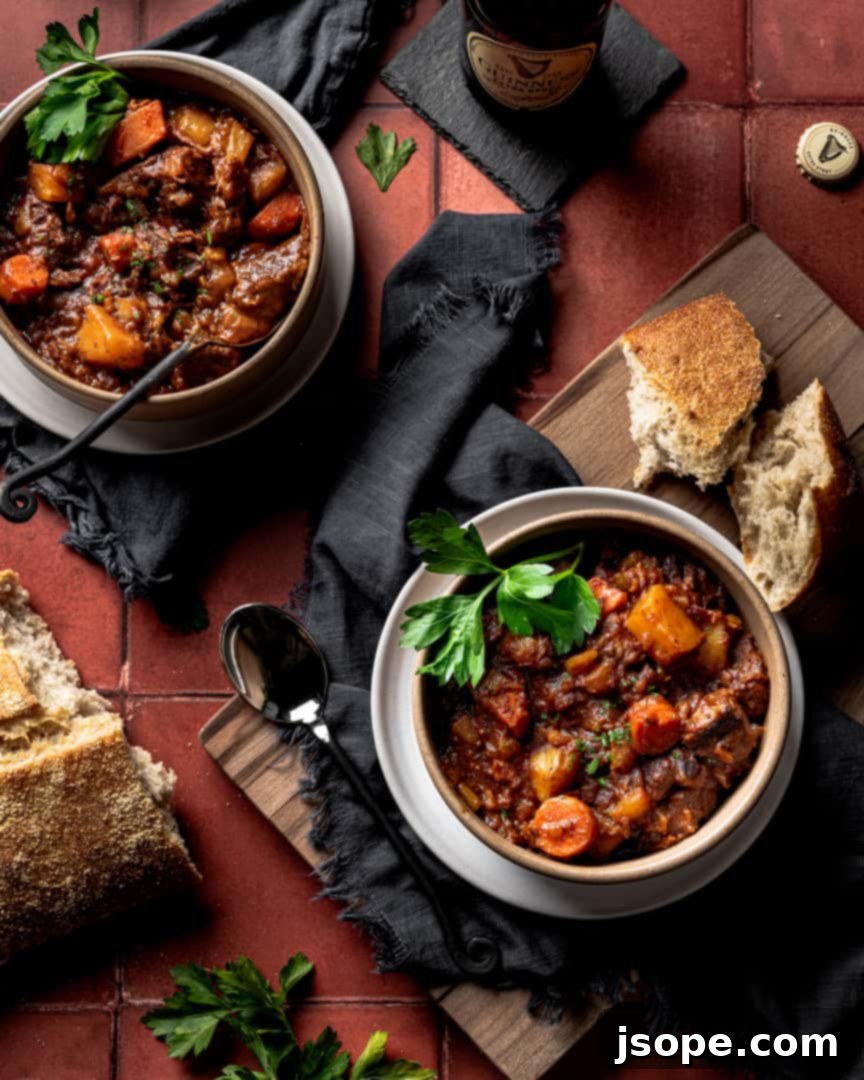
Step-by-Step Instructions for Your Guinness Beef Stew
Follow these detailed steps to create a rich and tender Guinness Beef Stew that will impress every time:
Step 1: Cook the Bacon and Sear the Beef
- Begin by preheating your oven to 350°F (175°C). Place your large Dutch oven or oven-safe pot over medium heat on your stovetop. Add the bacon pieces and cook until they are crisp and beautifully browned. As the bacon cooks, lightly sprinkle the cubed beef with all-purpose flour. Once the bacon is cooked, use a slotted spoon to transfer it to a large bowl, leaving the rendered fat in the pot. Now, add a single layer of floured beef cubes to the hot pot. It’s crucial not to overcrowd the pot; sear the beef in batches to ensure a proper brown crust develops on all sides. A good sear is vital for deep flavor. As each batch of beef browns, remove it and add it to the bowl with the cooked bacon.
Step 2: Build the Flavor Base with Onions and Garlic
- With the beef seared and removed, add the chopped onions to the pot, utilizing the flavorful beef drippings (fond) left at the bottom. This brown coating is packed with savory goodness – do not discard it! Cook the onions for approximately 3 minutes, stirring occasionally, until they begin to soften and become translucent. Next, add the minced garlic and tomato paste to the pot. Stir constantly for 1 minute, allowing the tomato paste to toast slightly and deepen its flavor. This step is crucial for developing the rich, umami base of your stew.
Step 3: Deglaze the Pot and Introduce Guinness
- Increase the heat to high. Immediately pour in about one-third of the Guinness beer. Use a wooden spoon to vigorously scrape the bottom of the pan, releasing all those incredible browned bits (the fond) that have built up. This process, known as deglazing, adds immense flavor to the stew. If you’re using a sturdy, nonstick-safe pot, a metal spatula can also be effective. If necessary, add another small splash of Guinness to help release any stubborn fond. Once all the fond is thoroughly scraped from the bottom of the pot, add the remaining Guinness and the beef stock, stirring well to combine.
Step 4: Slow Cook to Perfection
- Reduce the heat on the stovetop to medium-high. Return the cooked bacon and seared beef to the pot, then add all the remaining ingredients: potatoes, turnips, carrots, celery, Worcestershire sauce, fresh oregano, rosemary, thyme, dried marjoram, bay leaves, kosher salt, black pepper, and molasses. Stir everything together thoroughly, bringing the mixture to a gentle boil. Once boiling, cover the pot tightly with a lid and carefully transfer it to your preheated oven. Allow the stew to cook for 1.5 hours. After this time, remove the pot from the oven, stir, and carefully test a piece of beef for tenderness. If the beef isn’t as tender as you desire, return the pot to the oven for an additional 30 minutes, or longer if needed, checking periodically until it reaches your preferred fall-apart consistency.
Step 5: Season, Garnish, and Serve
- Once the stew is perfectly cooked and the beef is tender, carefully remove the pot from the oven. Taste the stew and adjust the seasoning with additional salt and freshly cracked black pepper as needed. Ladle generous portions into bowls, then garnish each serving with a sprinkle of fresh chopped parsley for a burst of color and herbaceous freshness. Serve this magnificent Guinness Beef Stew with plenty of crusty bread for soaking up every last drop of the rich, flavorful broth.
Exciting Variations for Your Beef Stew
While our Guinness Beef Stew recipe is a masterpiece on its own, here are a couple of ways you can creatively adapt it to suit different tastes or dietary preferences:
- Make it Vegetarian: For a delicious plant-based option, you can certainly adapt this recipe. Omit the bacon and beef entirely, and substitute the beef stock with a rich vegetable broth. To maintain the heartiness, increase the quantity and variety of vegetables. Consider adding peas, green beans, or even robust mushrooms for extra texture and umami. Keep in mind that traditional Worcestershire sauce contains anchovies, so if you’re aiming for a strictly vegetarian or vegan dish, ensure you use a suitable plant-based Worcestershire alternative.
- Experiment with Different Beers: While the deep, malty character of Guinness is absolutely perfect and contributes uniquely to this stew, you could explore other dark, full-bodied beers. The key is to choose a beer that isn’t too heavy on the hops, as excessive hoppy bitterness can become pronounced during the long cooking process. Stouts, porters, or dark ales that are known for their smooth, rich profiles would be good candidates. Brands like Boddingtons Pub Ale or a traditional English porter could offer an interesting twist, though it’s worth noting these would steer the stew away from its distinct Irish roots.
Storing and Reheating Your Guinness Beef Stew
One of the many joys of a good stew is how well it keeps, and often, how its flavors deepen over time. Here’s how to properly store and reheat your Guinness Beef Stew:
- How to Store Leftover Guinness Beef Stew: Once your stew has cooled down to room temperature, transfer it to an airtight container. Store it in the refrigerator for up to 5 days. You’ll likely find that the flavors meld and become even more profound and delicious with each passing day!
How to Reheat Leftover Beef Stew:
- For best results, place the desired amount of stew in a covered pot on the stovetop over low to medium-low heat. Stir occasionally to ensure even heating and prevent sticking. Continue reheating until the stew is thoroughly hot and the beef and vegetables are warmed through. You can also reheat individual portions in the microwave, stirring halfway through, until piping hot.
Can You Freeze Guinness Beef Stew?
- Yes, this stew freezes beautifully! It will retain most of its delicious flavor and texture for several months. To freeze, ensure the stew is completely cool. Transfer it to freezer-safe containers or heavy-duty freezer bags, leaving a little headspace for expansion. Thaw overnight in the refrigerator before reheating. Freezing is an excellent way to prepare large batches and enjoy comforting meals whenever you need them.
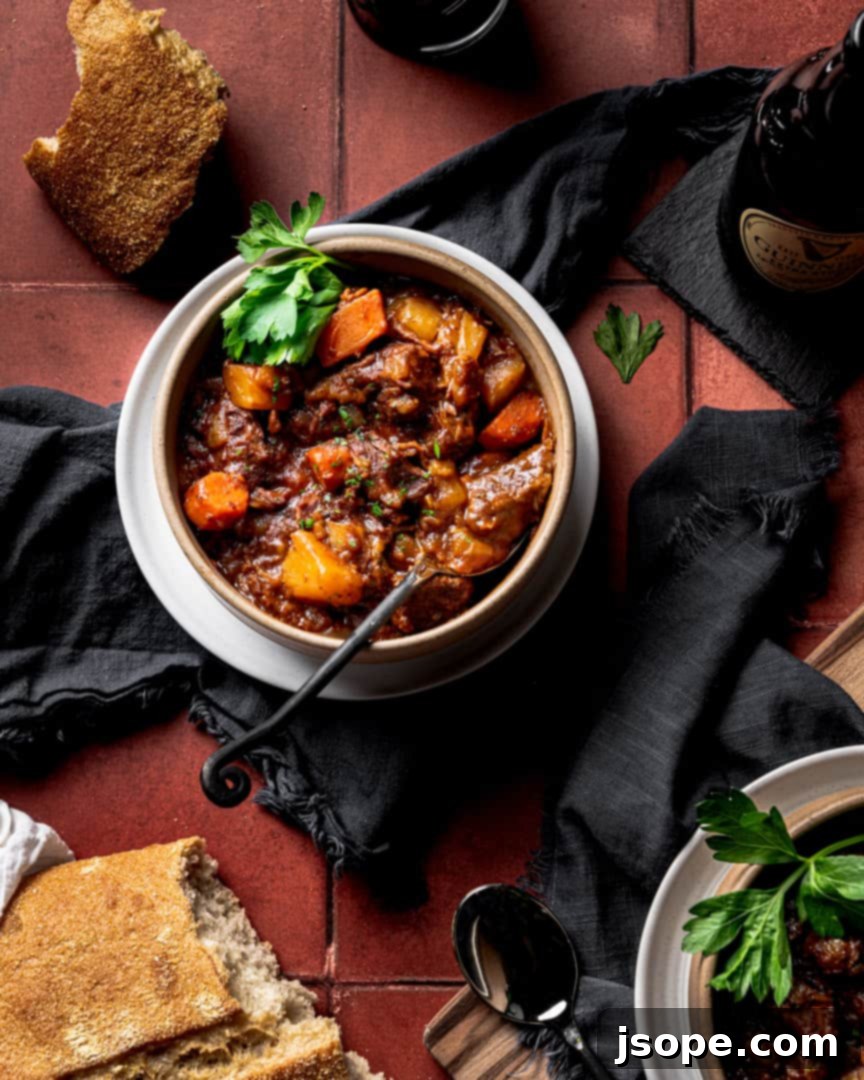
Pro Tip for an Unforgettable Guinness Beef Stew
The secret to an incredibly flavorful Guinness Beef Stew lies in the fond. After browning your bacon and searing your beef, you’ll notice a dark, caramelized layer sticking to the bottom of your pot. This isn’t burnt; it’s a treasure trove of flavor! Take your time and use a bit of elbow grease during the deglazing step with the Guinness to scrape up every single browned bit. Even if it looks very dark, these bits are packed with concentrated umami and will dissolve into your broth, adding an unparalleled depth and richness to your hearty Guinness Beef Stew. Do not skip this crucial step!
Common Issues and Quick Fixes for Your Beef Stew
Even experienced cooks encounter occasional hiccups. Here are the three most common issues you might face with beef stew and how to easily resolve them:
- Beef Not Tender Enough: This is arguably the most common concern. If, after the recommended cooking time, your beef is still tough, simply continue to cook the stew in the oven for another 30 minutes, and then test again. Repeat if necessary. The beauty of slow cooking is that time usually solves this problem. While sirloin and lamb tend to become tender reliably, cuts like chuck or round might require a bit more patience.
- Stew Too Thick: If your stew has become too thick for your liking, don’t worry! This is an easy fix. Gradually stir in a little more beef stock until it reaches your desired consistency. Remember to taste the stew again once thinned and adjust the seasoning (especially salt) to ensure the flavors are still perfectly balanced.
- Stew Too Thin: Conversely, if your stew is thinner than you’d prefer, a cornstarch slurry is your best friend. In a small bowl, start with just one teaspoon of cornstarch and add an equal amount of cold water (or just enough to fully dissolve the cornstarch), stirring until smooth. Pour this slurry into the simmering stew, stir it in well, and bring the stew back to a boil. The heat will activate the cornstarch, causing the stew to thicken. If it’s still not thick enough, you can always make and add another small slurry until you achieve the perfect consistency.
Perfect Pairings: What to Serve with Guinness Beef Stew
Guinness Beef Stew is a substantial and satisfying meal on its own, but certain accompaniments can elevate the dining experience. Here are some delicious ideas:
- Crusty Bread: This is a classic and indispensable pairing. A warm, crusty baguette or sourdough loaf is perfect for soaking up every last drop of the rich, flavorful broth, ensuring no deliciousness goes to waste.
- Mashed Potatoes: Serving the stew over a bed of creamy mashed potatoes is a wonderfully comforting option. The potatoes provide a soft counterpoint to the tender beef and a delightful way to enjoy the stew’s gravy.
- Rice: For a lighter carbohydrate base, serve your Guinness Beef Stew over fluffy white or brown rice. The rice absorbs the savory sauce beautifully.
- Colcannon: For an authentic Irish touch, serve with Colcannon – a traditional Irish dish made with mashed potatoes, cabbage or kale, and butter.
- Green Salad: A simple, crisp green salad with a light vinaigrette can provide a refreshing contrast to the richness of the stew, balancing the meal beautifully.
Ideal Drink Pairings for Guinness Beef Stew
Enhance your dining experience with the perfect beverage. Here are our top recommendations for what to drink with Guinness Beef Stew:
- Guinness Stout: Unsurprisingly, a pint of Guinness Draught is the ultimate pairing. The flavors of the beer in the stew are perfectly complemented by a fresh, cold pint, creating a harmonious and truly Irish experience. Its creamy texture and roasted notes echo the stew’s depth.
- Bold Red Wine: If wine is your preference, opt for a robust red wine that can stand up to the rich flavors of the beef and the stout. A Cabernet Sauvignon, Petite Sirah, or any full-bodied red blend would be an excellent choice. Their strong tannins and dark fruit notes will cut through the richness of the stew beautifully.
- Whiskey: For a true taste of Ireland, a glass of Irish whiskey, neat or with a splash of water, can be a delightful digestif or a sophisticated pairing, offering warmth and complex notes that complement the stew.
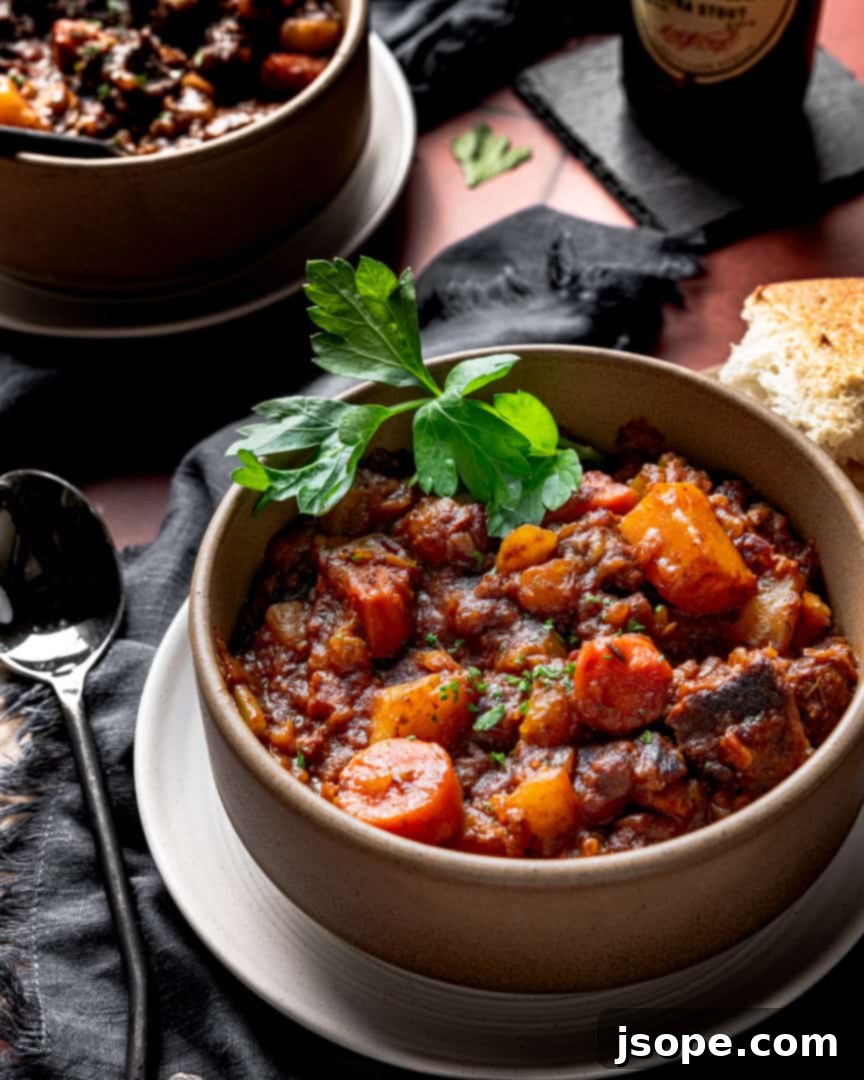
Frequently Asked Questions About Guinness Beef Stew
Bitterness can sometimes be an issue with stews, especially when using dark beers like Guinness, as the alcohol cooks off and concentrated flavors can emerge. This particular recipe is designed to counteract bitterness with natural sweetness from carrots and molasses. If you find your stew is still too bitter, you can easily balance it by adding a small amount of white sugar, brown sugar, or honey, one teaspoon at a time, until the bitterness is mellowed to your preference.
Absolutely! Guinness is a fantastic ingredient for cooking, much like many other beers. Its malty, roasted notes add incredible depth and umami to savory dishes. However, as with any beer, it can become slightly bitter when reduced due to the concentration of hops and other flavors. The key is to balance this with sweet elements, as we do with carrots and molasses in this recipe, or to select a beer that isn’t excessively hopped to begin with.
The primary distinction often lies in the choice of meat and specific regional ingredients. Traditional Irish stew is more commonly prepared with lamb or mutton, although beef variations exist. It also typically uses specific vegetables like potatoes, onions, and sometimes carrots. General beef stews can vary widely in their ingredients, spices, and liquid bases, often incorporating different vegetables, broths, and sometimes wine. Our Guinness Beef Stew bridges these traditions, using beef and the iconic Irish stout for a distinct flavor.
Yes, you certainly can! For a truly authentic Irish experience, you could replace the beef with lamb or mutton. If you’re looking for a plant-based alternative, please refer to our “Variations” section above for suggestions on creating a delicious vegetarian version. Just remember to adjust your stock and check all ingredients for suitability if you have specific dietary restrictions.
📖 Recipe Card: Guinness Beef Stew

Hearty Guinness Beef Stew
5 from 1 vote
Pin Recipe
Ingredients
- 8 oz bacon – cut into ½ inch pieces
- 2.5 lbs sirloin – cubed into bite-sized pieces
- 3 tbs all purpose flour
- 2 cups chopped yellow onion
- 2 large cloves garlic – minced
- 6 oz tomato paste
- 4 medium waxy potatoes (e.g., Yukon Gold) in 1 inch dice
- 1 large turnip in 1 inch dice
- 2 large carrots in ¾ inch chunks
- 2 stalks celery in ½ inch pieces
- 1 pint Guinness Draught beer
- 4 cups good quality beef stock (low sodium preferred)
- 3 tbs Worcestershire sauce
- 1 tablespoon fresh chopped oregano
- 1 tablespoon fresh chopped rosemary
- 1 tablespoon fresh chopped thyme
- 1 teaspoon dried marjoram
- 2 bay leaves
- 1 tablespoon + 1 teaspoon kosher salt
- 1 teaspoon freshly cracked black pepper
- 2 teaspoons molasses
- Additional Salt and Pepper to taste (for serving)
- Chopped fresh parsley for garnish
Instructions
- Preheat your oven to 350°F (175°C).
- Heat a large Dutch oven or oven-safe pot over medium heat on your stovetop. Add the bacon pieces and cook until they are crisp and browned. While the bacon cooks, sprinkle the beef cubes with all-purpose flour. Once the bacon is done, remove it with a slotted spoon to a large bowl, leaving the rendered fat in the pot. In batches, add the floured beef to the hot pot and sear on all sides until nicely browned. Transfer the browned beef to the bowl with the cooked bacon.8 oz bacon – cut into ½ inch pieces, 2.5 lbs sirloin – cubed into bite-sized pieces, 3 tbs all purpose flour
- Once the beef is browned and removed, add the chopped onions to the pot, utilizing the beef drippings. Cook the onions for about 3 minutes until softened. Then, add the minced garlic and tomato paste, stirring constantly for 1 minute to develop their flavors.2 cups chopped onion, 2 large cloves garlic – minced, 6 oz tomato paste
- Turn the heat to high. Immediately add about one-third of the Guinness, scraping the bottom of the pan with a wooden spoon to release all the flavorful browned bits (fond). Add another splash of Guinness if needed to fully deglaze. Once all the fond is released, add the remaining Guinness and beef stock.1 pint Guinness beer
- Reduce the heat to medium-high. Add all remaining ingredients (potatoes, turnips, carrots, celery, Worcestershire sauce, herbs, salt, pepper, molasses) and stir to combine. Bring the pot to a boil, then cover with a lid and transfer to the preheated oven for 1.5 hours. After 1.5 hours, remove from the oven, stir, and test the beef for tenderness. If needed, return to the oven for another 30 minutes or until the beef is perfectly tender.4 medium white or yellow (waxy) potatoes in 1 inch dice, 1 large turnip in 1 inch dice, 2 large carrots in ¾ inch chunks, 2 stalks celery in ½ inch pieces, 4 cups beef stock, 3 tbs Worcestershire sauce, 1 tablespoon fresh chopped oregano, 1 tablespoon fresh chopped rosemary, 1 tablespoon fresh chopped thyme, 1 teaspoon dried marjoram, 2 bay leaves, 1 tablespoon + 1 teaspoon salt, 1 teaspoon black pepper, 2 teaspoon molasses
- Once done, remove from the oven. Season with additional salt and freshly cracked black pepper to taste. Garnish generously with chopped fresh parsley and serve immediately with crusty bread.Salt and Pepper to taste, Chopped parsley for garnish
Nutrition Information
Savor Every Spoonful: Conclusion
We truly hope you’ve enjoyed this detailed guide to creating an unforgettable Guinness Beef Stew! This recipe, steeped in rich tradition and bursting with flavor, is more than just a meal—it’s an experience designed to bring warmth and comfort to your home. The tender beef, hearty vegetables, and deep, malty broth create a symphony of tastes that perfectly captures the essence of Irish comfort food.
If you embark on this culinary adventure and give our Guinness Beef Stew recipe a try, we’d absolutely love to hear from you! Please leave us a comment below to share your experience, or tag us on Instagram @cooking_with_wine. Your feedback and photos truly inspire us!
For those who love the comforting embrace of a warm bowl, be sure to explore more of our delicious soup and stew recipes to keep you cozy all year round:
- Cozy Homemade Chicken and Dumplings
- Restaurant Style French Onion Soup
- Easy Homemade Creamy Clam Chowder
- Hearty Chili with Kidney Beans
